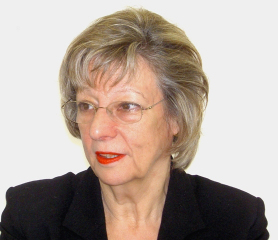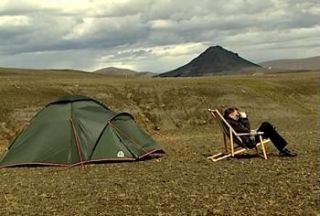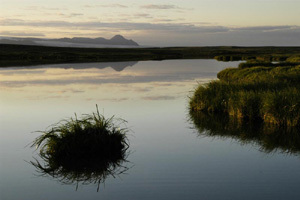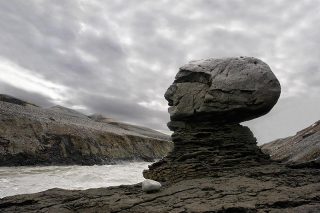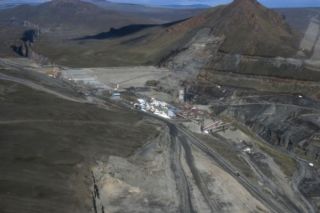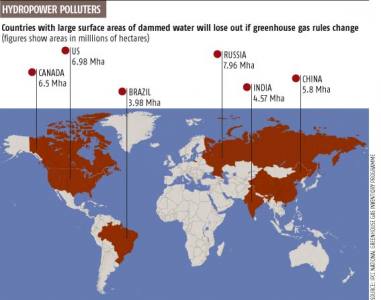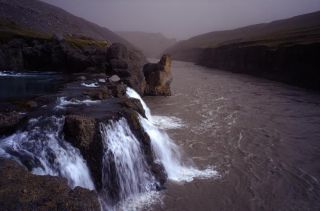Apr 21 2005
Fire & Ice – Benefit
Iceland is under attack and needs international support to stop Corporate Companies destroying their beautiful landscapes. This is under the guise of a “benefit” for the community, but has been opposed since it began. No -one wants this to happen and it can be stopped!
A group of individuals wishing to support this campaign are raising funds to visit Iceland and raise the profile of this campaign thru’ a sponsored firewalk (yes, walking over hot coals!) to take place early June in Scotland. Read More
Apr 19 2005
British MPs Support Our Campaign Against the Icelandic Dams
The Icelandic government and media tried to hush this story up by not reporting it for months! When environmental activist Olafur Pall Sigurdsson was being interviewed on a chat programme on the State Radio about hypothetical questions of civil disobedience he seized the opportunity and read aloud the whole of Doughty’s EDM. The programme presenter was seriously reprimanded by her bosses for allowing this.
British MP Sue Doughty has tabled a Parliamentary motion calling on the British Government to use its diplomatic links with Iceland to persuade the Icelandic Government to terminate the building of a series of dams in the Icelandic Highlands.
Read More
Apr 17 2005
SOS Saving Iceland Audio Interview
The founder of Saving Iceland/NatureWatch, Olafur Pall Sigurðsson, interviewed here on Radio IndyMedia.org.
http://www.indymedia.org.uk/en/2005/04/309355.html
Apr 13 2005
Saving Iceland: The Buck Stops Here
CorporateWatch.org
Newsletter Issue 23 April/May 2005
In March 2004, the government of Iceland held a conference in the capital Reykjavik. It was a private conference, attended by representatives of the top multinational corporations, Rio Tinto, Alcoa and Alcan among them, and the population were not told about it in advance. Iceland, a government spokesman informed its people afterwards, was now open for business. Read More
Mar 05 2005
Icelandic Wetlands Saved
Lowana Veal
The Thjorsarver wetlands in South Iceland have been saved from the ravages of a hydro-electric scheme, at least for the foreseeable future.
Thjorsarver is a wetlands area that became listed as a RAMSAR site in 1990, principally because it is home to the world’s largest breeding ground for pink-footed geese, 6-10,000 breeding pairs. But many other birds nest there too, such as the purple sandpiper, red-necked phalarope, dunlin, Arctic tern, Arctic skua, ptarmigan, golden and ringed plovers, snow bunting and long-tailed duck. Botanically, it is home to 167 species of vascular plants as well as mosses and lichens, some of them rare. The insect life is rich.
Paradoxically, the designation of RAMSAR and nature reserve status should mean that the area be left untouched – but those with vested interests appeared to disregard this point. Read More
Mar 04 2005
3 Comments
Ice Burks! – Schnews
This article served as a follow-up to the ‘Power Driven’ article published in the Guardian in November 2003.
Schnews, 4th March 2005, Issue 487
Super-cool Iceland, the eco-tourist’s wet dream, right? Maybe not for much longer if the Icelandic government has its way.
You see, they’ve got a cunning plan to turn the whole country into a heavy industry paradise for all sorts of multinational scum, damming and flooding and generally trashing nature to power up a bunch of giant aluminium smelters and other slight blots on the landscape.
This is not an early April fool – it’s already started. The construction of the giant Karahnjukar dam in the Icelandic Highlands – one of Europe’s last surviving wildernesses – is well under way. Landsvirkjun (the national power company, a government quango) has a raft of further projects that would see 25% of the entire country dam affected by 2020: some vision.
Karahnjukar and most of Landsvirkjun’s future schemes harness glacial rivers fed by Vatnajokull – the biggest non-arctic glacier in the world. This glacier is the heart of a fantastically intricate eco-system: barren red and black Martian landscapes; geo-thermal springs and pools hot enough to take a bath in; rivers banked by deep, springy emerald green moss woven with tiny red and yellow flowers where no-one’s ever walked; the glacier’s own fantastic ice caves; seal breeding grounds on the black sand deltas to the north. All this will be destabilized and damaged forever if these dam projects are allowed to happen.
An international protest camp this summer aims to halt this war on nature. It’s going to be one hell of a struggle since the Icelandic government seems determined to push these projects through, no matter what opposition it faces.
What’s going on at Karahnjukar demonstrates the way that government operates. When plans for the mega-project were first submitted to the National Planning Agency (NPA) in 2001 they were rejected because of the “substantial, irreversible, negative environmental impact” the dam would have. All the experts agreed with this verdict (see IRN’s report linked below). But the environment minister overturned the NPA’s ruling and declared that in her opinion the project was environmentally acceptable – of course she is suitably qualified to decide on environmental issues – she’s a physiotherapist! There were a few financial hiccups with banks getting all ethical but Barclays bravely stepped forward with the necessary dosh – even though they’d signed up to the Equator Principles which demand “sound environmental management practices as a financing prerequisite.”
Work started in July 2003, with Italian bully-boys Impregilo (construction arm of Fiat, currently charged with corruption in Lesotho and ‘financial irregularities’ at home) and a terrifying squadron of Caterpillar bulldozers began to claw up and dynamite the fragile sub-arctic tundra. Reindeer, arctic foxes, other small animals and thousands of bird species that lived there fled in fear.
FROZEN ASSETS
All electricity produced at Karahnjukar is contracted to a massive Alcoa aluminium smelter (being built by Bechtel, due to be operational in 2007) which itself will pollute and ruin Reydarfjordur, a pristine eastern fjord. A Reykjavik court recently ruled that Alcoa’s planning permission for this monstrosity isn’t valid, but that probably won’t stop them as they immediately appealed to the – allegedly – rigged High Court.
Karahnjukar won’t benefit Icelanders at all: none of the electricity is destined for the national grid and cos there’s little unemployment in the region no Icelander’s gonna want a nice healthy job at the smelter thanks.
Yet the cost to the nation is enormous: independent experts say the economy is at risk (see IRN report), it has cost $1 billion so far and is likely to cost more – the electricity for Alcoa is for a price linked to the changing prices of Aluminium on London Metal Market…in other words no guarantee it’ll ever make a profit.
The environment suffers more by the day. They’ve already blown part of Dimmugljufur – Iceland’s Grand Canyon – to smithereens, and if they fill up the reservoir (scheduled 2007), 65.5 square kilometres of pristine wilderness will be completely submerged. This land includes birthing grounds for the majority of Iceland’s reindeer and Ramsar ‘protected’ nesting sites for endangered species such as pink-footed geese, and Gyrfalcon. Sixty waterfalls will be lost as will a range of sediment ledges – judged completely unique in the world by scientists studying global warming – which record 10,000 years of geological and climate change. And this vast projected reservoir would extend right onto the glacier itself, which is breaking up because of global warming. Wouldn’t giant icebergs trucking up to the dam be a bit – er – dangerous? Yep. And it gets worse – the dam is being built over a seismic fault!
White lines = Ground rock cracks
Yellow lines = Erosion of sediments. Erosion is parallel
to cracks: Sediments are cracked, cracking is still active
Environmentalists also warned that silt residues left by changing water levels round the projected reservoir would dry to a fine dust which the wind would carry onto local farmland. This was dismissed, yet last summer silt left in the wake of unexpected surges in the newly diverted glacial river produced just such devastating dust storms.
But none of this makes any difference: while everyone else in the ‘developed world’ is busy dismantling dams, Iceland’s rulers just can’t get enough. There are plans to dam every major glacial river in the country. Rio Tinto Zinc are reportedly salivating over the chance to devastate the North of the country, while Alcan and Century (who’ve already got smelters near Reykjavik) are keen to expand their deathly shadow in the south.
Ironically, the government- via its tourist board – still invites visitors to enjoy the “unspoilt pure natural beauty” it’s hell-bent on destroying! So how do they get away with it? Well, Iceland has a tiny population (290,000) and power is concentrated in the hands of a few very wealthy families who control politics, industry and the media. Scientists, journalists, anyone who asks questions is swiftly discredited and then sacked.
But it’s not all bad news and you can even help. A really vigorous and up-for-it grass-roots environmental movement is emerging, determined to stop Icelandic nature being pimped to the highest bidder. It’s a David v. Goliath battle and the call is out for international support.
If you are up for peacefully showing your solidarity with some of the most fantastic nature on our planet, check out www.savingiceland.org and joining the protest camp summer 2005.
Feb 26 2005
1 Comment
Environmental Impact of the Kárahnjúkar Dams
The Kárahnjúkar Power Plant is the largest industrial development in Iceland’s history. Roughly 3% of the total area of Iceland, approx. 290,000 ha, will be impacted by the project, not including areas of secondary impacts, such as windblown dust, long-term erosion, downstream or coastal silt and soil deposits, alterations in groundwater characteristics in peripheral areas with resulting changes in vegetation and wildlife habitats. Read More
Feb 26 2005
Hydroelectric Power’s Dirty Secret Revealed – New Scientist
Hydroelectric dams produce significant amounts of CO2 and methane – some produce more greenhouse gases than fossil fuel power plants.
Duncan Graham-Rowe, New Scientist, 26-2-2005, issue 2488
Contrary to popular belief, hydroelectric power can seriously damage the climate. Proposed changes to the way countries’ climate budgets are calculated aim to take greenhouse gas emissions from hydropower reservoirs into account, but some experts worry that they will not go far enough.
The green image of hydro power as a benign alternative to fossil fuels is false, says Éric Duchemin, a consultant for the Intergovernmental Panel on Climate Change (IPCC). “Everyone thinks hydro is very clean, but this is not the case,” he says.
Hydroelectric dams produce significant amounts of carbon dioxide and methane, and in some cases produce more of these greenhouse gases than power plants running on fossil fuels. Carbon emissions vary from dam to dam, says Philip Fearnside from Brazil’s National Institute for Research in the Amazon in Manaus. “But we do know that there are enough emissions to worry about.”
“Reservoirs convert carbon dioxide in the atmosphere into methane, which has 21 times the warming effect” Read More
Jan 26 2005
Iceland Under Attack – Threatened Protestors Raise Stakes, Call for International Protest
Sauðárfossar – Amongst numerous waterfalls destroyed by the Kárahnjúkar dams
Corporate Watch
“Nobody can afford to allow the divine Icelandic dragon of flowers and ice to be devastated by corporate greed”
People in Iceland are calling for an international protest against the building of a series of giant dams, currently under construction in the eastern highlands of Iceland. The dams are designated solely to generate energy for a massive aluminium smelter, which will be run by the US aluminium corporation Alcoa and built by Bechtel.Not a single kilowatt of energy produced by the dams will go for domestic use. Alcoa is seizing the chance to relocate to Iceland after costs of producing aluminium in the US soared. Read More
